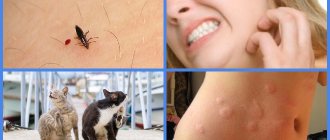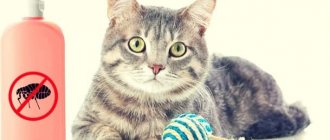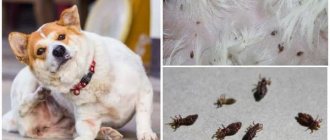What do fleas look like on dogs and how do they reproduce?
Dog fleas are small - their body length is about 2-4 mm. The chitinous cover, consisting of many bristles, allows the parasite to firmly adhere to the fur and move quickly. Fleas jump well - 3 times further than they can see.
This canine parasite is hardy, so it tolerates sudden temperature changes, high humidity, and even develops resistance to chemicals.
The flea's mouthparts are adapted to the dog's skin, but if there is a lack of food, the parasite can bite a person or other animal. If there is not enough food, the insect hibernates.
The flea has a complex reproductive system. Mating can last up to 10 hours. Almost all parasites begin copulation after drinking blood. After fertilization, the female immediately lays eggs. A flea can lay up to 10 eggs at a time.
Reproduction occurs in favorable conditions: in rags, dust, woolen products, a booth, on the floor, in clothes. The eggs are oblong in shape and resemble grains of rice.
How to detect the presence of fleas in the house?
If you begin to notice itching on your legs, especially at night, then there is a high probability of fleas in your apartment. Detecting them is quite difficult, but there is a special detection method:
- determine which room the fleas have settled in;
- lay several sheets of white paper or a white sheet on the floor;
- leave the room for a few minutes, then check the white canvas - if black dots appear on it, which disappear when approached, these are fleas.
Reasons for appearance
The flea invasion occurs in the warm season and begins in spring and ends in October. Parasites choose their refuge in private houses or on the first floor of apartment buildings.
Fleas can be caused by contact with other dogs.
The main sources are:
- dirty entrances;
- neighboring apartments;
- infected pets;
- flea colonies in the basement or attic;
- presence of rats and mice;
- garbage dumps.
Fleas lay eggs in an animal's fur, so the owner can transmit parasites to his pet if he first pets an infected dog and then a healthy one.
Are fleas transmitted from dogs to humans?
Fans wonder: can fleas pass from a dog to a person? Yes, this is a serious issue that needs to be looked at carefully. These are dangerous blood-sucking insects that can introduce infection into the body.
Stroking the dog once is safe; during it, insects will not be able to jump onto the surface of the body. This will not save you from germs, so you need to wash your hands with soap. And if a dog starts to itch after a walk outside, this may be a signal that it has parasites.
The owner should take into account that furry dog breeds may have more fleas:
- Affenpinscher;
- Alaskan Malamute;
- Border Collie;
- Irish Wolfhound;
- Pekingese;
- Pomeranian Spitz;
- Samoyed dog;
- Tibetan mastiff;
- Chow-chow;
- Sheltie;
- Shih Tzu;
- Japanese Spitz;
- Scottish Collie.
It is advisable to immediately begin removing bloodsuckers. If you start it, then after a short period of time there will be a lot of parasites, they will begin to spread and bite your legs. With severe hunger, other parts of the body are attacked - arms, back, stomach, face.
The food is the blood of animals.
They live and hide in the fur of dogs. And the hair on people’s bodies will not allow bloodsuckers to settle in and lay eggs. This means that insects cannot settle on the body.
Are fleas transmitted from dogs to humans? Insects attack people when they feel hungry. The main habitats are the bedding of dogs, cats, garbage, where there is an increased likelihood of being bitten.
Can they transfer to people?
Fleas cannot live on humans, so they are not transmitted to people from sick animals. However, if your pet brings this insect back from a walk, immediate action should be taken. If there are too many fleas, they may bite people in search of food.
Fleas live on bedding or carpets, in garbage. If, for example, an animal left the house for some time, and parasites remained on its blanket, then they will begin to attack people in order to satisfy their hunger.
How they bite
The oral apparatus is designed in such a way that it is convenient to suck blood . Fleas' sense of smell allows them to identify humans by the smell of carbon dioxide. Once on the body, the insect bites through the skin and begins to suck blood. The parasite's proboscis is short, so it inserts both its head and part of its body into the wound, assuming a vertical position.
The flea does not mask the bite with an anesthetic, so it causes pain to the victim. During the puncture process, the insect injects saliva, which impairs blood clotting, and along with it harmful bacteria.
Having received a portion of blood from one wound, the parasite crawls a few centimeters and makes a new one. During one feeding, the insect makes 3-5 bites.
Flea bites.
Consequences of bites
The consequences of a bite can be:
- various skin lesions, ranging from severe itching to abscesses and dermatitis;
- high fever;
- development of brucellosis;
- transfer of worms, tapeworms from the previous “owner”;
- sleep disturbance.
When scratching the bite area, boils, abscesses and growths can form.
An allergic reaction is a common consequence.
What consequences can dog flea bites cause?
If a dog has any parasites, the risk of their carriers being transferred through fleas to the human body increases. You don’t have to have pets to bring fleas into your home—prolonged physical contact with a stray dog can have the most negative consequences.
The degree of danger of dog fleas to humans depends on many factors, so possible harm can be expressed in the following:
- the occurrence of an allergy in a person to the saliva of a bloodsucker - itching, dermatitis appears, chronic skin diseases worsen, body temperature rises, respiratory and intestinal disorders worsen;
- brucellosis develops, which can lead to damage to internal organs;
- from the previous “carrier” a person can get endoparasites – worms, tapeworms, and other types of parasites;
- A flea bite can cause many dangerous diseases: encephalitis, ulcers, typhus, plague. This happens extremely rarely.
How to fight
If parasites are found, disinsection must be carried out. To treat the room you will need a soda or saline solution (you can also add insecticidal shampoo).
The algorithm of actions is as follows:
- Thoroughly vacuum the entire apartment, including upholstered furniture.
- Send for cleaning things that could harbor pests.
- Throw out the animal's bedding (it is recommended to change it more often), and treat all items belonging to the dog.
- Carry out wet cleaning with a solution.
- Close doors and windows hermetically.
- Move furniture away from the wall, treat all cracks, corners, carpets and other surfaces with insecticide.
- Leave the apartment for a few hours.
- Upon return, ventilate well.
- Do the cleaning again.
An option for flea control is a collar.
This treatment must be repeated after a week to ensure that both larvae and eggs are destroyed.
In a private house, it is necessary to treat not only the interior, but also the basement, cellar, attic and all outbuildings and the surrounding area.
Dog house treatment
The booth is disinfected after it is cleaned. To avoid “flooding”, you first need to dig drainage ditches at an angle. The entire house needs to be treated, both inside and outside.
The procedure can be carried out using an aqueous solution of formalin, creolin or Lysol. Creolin is used more often because it is easier to buy and easier to dilute with water.
Regular scheduled treatments are carried out in winter, spring and autumn. In summer, disinfection is carried out every month. The kennel is washed out unscheduled with a solution if a flea infestation has been detected, or before moving a new pet into it.
Whatever solution is used for treatment, the animal should not be allowed near the booth until it is completely dry. Otherwise, there is a risk of harming your pet's health.
Animal handling
It is possible to remove these parasites yourself at home if a severe infection has not yet occurred.
The fastest way to get rid of parasites is to use a spray. After treatment, the drug begins to act instantly, the protective effect lasts about a month. Before spraying, you need to straighten the animal's fur so that the liquid gets on the skin. Everything is treated except the head. The pet needs to be occupied with playing for a while so that the drug has time to dry.
Drops are considered a more effective remedy, but they begin to act only on the 2nd day. During this period, the animal should not be bathed so as not to wash off the medicine. The drug is applied directly to the skin from the back of the head to the withers.
A special flea collar is the safest remedy. A plastic headband with insect repellent is more suitable for prevention. You need to wear it constantly, it begins to act gradually. The duration of the collar is indicated on the packaging.
Prevention
As a preventive measure, it is recommended to use drops on the withers (Frontline, Advantix or Charter) or an anti-flea collar (Foresto, Kiltix). These products last up to 8 months and effectively protect dogs from fleas and ticks. You can also use specialized shampoos.
These simple precautions will keep the animal healthy and save owners from having to remove fleas from the apartment. If infection occurs, treatment begins immediately. This will help prevent complications.
Symptoms of bites in humans
A person’s reaction to a flea bite depends on the characteristics of the body. Some feel a stabbing sensation at the moment of biting the skin, others experience an unpleasant burning and itching a little later or after finishing sucking.
A flea bite is accompanied by the following symptoms:
- red spots with swelling of the skin at the site of the bite, similar to traces of mosquito bites (up to 5 millimeters);
- swelling surrounding the spot usually goes away after a few hours;
- severe itching, burning, desire to scratch the affected area of the skin.
The spots and itching persist for up to two days. Other reactions largely depend on the individual characteristics of a person. Some develop blisters, noticeable swelling, and hives caused by the enzymes introduced by the flea.
How to recognize fleas
Insects move by jumping; they do not live on the human body, but only feed. Bite sites are most often localized on the ankles, where they are able to jump. If an apartment is infested with fleas, then when a person is sleeping, they can bite him anywhere.
You can detect fleas:
- by the characteristic bite spots that will appear regularly, because individuals need to eat;
- according to the appearance of the discovered insects, the color is brown, size is 2-3 millimeters, the hind legs are longer than the others, there are 6 legs in total;
- scattered eggs of small size and white-transparent appearance - in the folds of furniture and bedspreads, rugs, where pets lie.
There is no doubt that if fleas live in the house, they will reveal themselves. Animals and people will itch constantly. Note that bites usually do not appear under hair; this localization is typical for lice.
Routes of transmission to humans
One should not blame only domestic animals for the appearance of fleas in people, although pets are most often their source. Fluffy fur and corners of sofas favored by pets are the main places where insects get onto humans.
Other sources of bloodsucking:
- livestock and their habitats;
- courtyard buildings;
- non-residential parts of premises - attics, basements, stairs;
- small pets – rats, birds, their cages.
Dirty basements, habitats of street animals and homeless people are usually heavily infested with fleas of various species. Fleas live where warm-blooded creatures live or frequent, giving them food. These can be nurseries for domestic or wild animals, dovecotes, chicken coops.
Habitats
Fleas are almost elusive; swatting them down requires a fair amount of dexterity. A person is a source of food, not a place of permanent residence. At the same time, insects have convenient means on their bodies for attaching to hair and tissues, so they can live in the fur and not leave the animals. People leave after satiation.
Fleas live in close proximity to humans:
- in secluded crevices of furniture and walls;
- in the folds of fabrics, covers, bedspreads;
- close to the habitats of animals and birds.
They love places where people rarely go to clean or ventilate, or move things. They often live in neighboring non-residential premises - closets, utility rooms, sheds.
Where is the greatest risk of catching a flea?
In fact, a person can encounter this unpleasant insect anywhere. This could be his own house, his neighbors' house, a park where he went with his family for a picnic, and so on.
And yet, most often a person encounters them in a house where animals live. In addition, they do not have to be pets - rats, mice and yard animals also carry fleas. Even birds can be carriers of this parasite. According to statistics, 3/4 of all domestic animals had fleas on their bodies.
As a rule, a person is bitten in places where an animal infected with fleas rests and cleans its fur. This could be his kennel, bedding, or just the carpet, where fleas like to hide when they lay their larvae and hide until their next meal.
Dog fleas, which bite humans least often, attack when the person passes near a doghouse. It just so happens that female insects love to lay their eggs there, after which they become monstrously hungry and attack anyone who passes nearby.
You are also most likely to encounter these nasty bloodsucking insects in the following places:
- shelters of wild animals (burrows, hollows and nests), near which hunters and forestry workers constantly pass;
- farms are constantly infested with various types of fleas, even though they are constantly being fought against;
- Since fleas infest rodents that live in meadows in parks, sitting next to a hole on a picnic, people become their victims.
No less often, pest control services receive calls from residents of old houses built during the Soviet Union. In dark basements where homeless animals live, fleas live for years, where they multiply, turning into huge colonies. When cold weather sets in, fleas move from the basement into apartments and begin to bite everyone who crosses their path.
Thus, it does not matter to the flea which warm-blooded animal it bites. Man, dog, rat or cat - everyone is under attack from these little bloodsuckers.
What danger do fleas pose to humans: the risk of contracting a serious disease
The bites themselves, even if they cause discomfort and itching, are not dangerous to humans. Diseases that can be transmitted to humans as a result of a bite pose a great danger.
There are often cases when a flea bite becomes a means of transmitting typhus, encephalitis or brucellosis.
Many do not even suspect that the plague has not gone away. It is still transmitted through the bites of fleas that live on rodents. However, now it is easily treated with antibiotics.
Folk remedies
The solution is to use simple but often effective means:
- regular combing of fleas with a comb is an absolutely safe method, the only drawback of which is that it is labor intensive;
- bathing in tar soap is a real replacement for special shampoos (just don’t overdo it: soap makes dogs’ skin very dry);
- washing the floors with a decoction of wormwood, laying out its stems is a mild, but time-tested preventive measure;
- rubbing the same wormwood into the fur, or tansy as an option (the main thing is that the smell is not too strong for the dog itself);
- using pine sawdust as bedding (suitable only for kennels).
Types of fleas
Fleas do not have wings and belong to the blood-sucking order. The body of insects is equipped with special devices (spikes) for attachment to the skin of animals whose blood they feed on. More than 2000 varieties are known. Some species, while not parasitizing on humans, can, if accidentally ingested, establish themselves in a person’s hair or clothing and live in an apartment.
On a dog
Dogs live on parasites called Ctenocephalides canis, or dog flea. This species is widespread everywhere, insects are not picky - they choose cats and rodents to parasitize, and will not refuse to bite a person. They are resistant to poor living conditions; they can live on the body from 3 months to a year and a half.
They spread Marseilles fever, plague, leprosy, and ctenocephalosis. They carry several types of parasites.
On a cat
Cats are favored by the insects Ctenocephalides felis, which also live on other animals and are also dangerous to humans. The bite of such a flea, when scratched, leads to purulent inflammation and a special type of dermatosis.
They carry plague, brucellosis, and rickettsiosis. The individual lives up to 2 years. A very dangerous type of flea, with severe infestation the animal develops anemia and exhaustion.
In public
According to scientists, the homeland of the human flea (Pulex irritans) is South America. In addition to people, it can live on domestic and wild animals. Carries plague and eggs of some parasites.
A skin disease caused by insect bites is called pulicosis. Produces a record number of eggs, laying them in secluded places in basements and quiet attics.
Cat lice: dangerous for the animal, but not contagious for humans
Lice are small, wingless insects with a flattened body. They are host specific. Unlike other external parasites, cat lice cannot live or move around in the environment. They spend their entire life cycle on a host animal. There are several types of lice. The most common parasite in cats is Felicola subrostratus.
The presence of lice is dangerous for your pet. When severely infected they cause:
- Itching
The itching is irrepressible, incessant, preventing your cat from living peacefully. By parasitizing the pet's fur, lice thin it, make it disheveled, sloppy, and cause the cat a lot of anxiety.
- Feline eczema
A severe infestation of lice can lead to miliary dermatitis, or feline eczema. It causes numerous blisters and bumps to form on the cat’s skin, with inflamed skin underneath. The affected areas of the skin are very itchy, the cat scratches them, and the wounds become infected. This only worsens the course of the disease.
Lice are also carriers of helminth eggs. As a result of this, helminthiasis and general exhaustion are added to the skin lesions of the infected animal. Lice spend most of their time attached with their paws to the base of an infested cat's hair. They feed on the epidermis, secretions of the sebaceous glands and blood.
Female lice lay eggs called nits. During her life, the female parasite lays 20-60 eggs and fixes them to the root part of the hair. After 7-12 days, the eggs hatch into larvae that look similar to adults, which after three molts turn into mature insects.
In large quantities, cat lice accumulate on the head, neck and at the base of the tail. These parasites infect pets of all breeds, except hairless cats. They are most often found in animals with long and thick hair.
What to do if you find a single flea
If at least one bloodsucker is detected, everything necessary must be done immediately to prevent further reproduction. Unfortunately, it is rarely possible to quickly detect insects. This is explained by the unexpressed symptoms of the first infection, so the parasites easily spread throughout the house and penetrate into furniture. It is quite difficult to remove them, and therefore there will be a high risk of re-infection for a long time. Measures to help prevent the spread must be applied in combination:
- Treat the entire room, booth, enclosure with chemical or folk remedies.
- Choose a flea medication for dogs according to age, size and health characteristics. If difficulty arises, you should seek advice from a veterinarian.
- During treatment, limit contact of the infected person with family members and other pets.
Timely measures taken to prevent reproduction and spread will help save your pet from health problems for a long time. A large number of methods of control and preparations for disinsection will save the house or apartment where the injured dog lives from being completely populated by unpleasant individuals. If you do not carry out the treatment on time, you will have to contact a veterinary pharmacy or veterinary clinic and find out how to get rid of fleas on your dog.
Emergency help for bites
The site of any insect bite should be washed well with running water and soap. When scratching, there is a high probability of introducing an infection from a neighboring area of skin.
Any alcohol-containing tinctures or antiseptics are suitable for treatment. You need to lubricate not only the wound, but also the area around it. Applying cold can help reduce itching and burning.
If there are signs of allergy development - severe swelling, sore throat, lacrimation - take an antihistamine.
For severe itching - Golden Star balm, plantain tincture, Fenistil, any remedy available in the home medicine cabinet.
Preventive measures to prevent fleas
It is much easier for a person to prevent the appearance of blood-sucking insects in the house than to get rid of them. Considering how fleas are transmitted, you can avoid their appearance. The most likely reason for the appearance of parasites in the house is unprotected animals that transport dangerous insects on themselves. A dog can pick up bloodsuckers while walking, playing with other infected animals, or at the entrance.
After every walk, you need to check your pet's fur. If a jumping insect is detected, the dog should be immediately bathed using appropriate shampoo. You should periodically check dog accessories: bedding, rugs, toys. Parasites do not use the body of their host for permanent residence. Once fed, they mate and lay eggs close to their prey. As a safe preventative measure, you can fill animal bedding with pine sawdust.
Preventive measures
The most optimal preventive measure is to purchase a special collar that will protect the dog not only from fleas, but also from many other insects. The Celandine collar has proven its effectiveness. Drops that are applied to the dog’s withers have proven themselves to be effective. They contain insecticidal agents, thanks to which not a single parasite will come close to your four-legged friend. There is a large selection of such products on sale. The best drops are:
- Frontline;
- Bars Forte;
- Barrier;
- Blokhnet;
- Advocate;
- Celandine;
- Advantix;
- Practitioner.
If you pet your dog on the street and suspect that it is infected with blood-sucking harmful insects, immediately take a shower and wash your hair when you arrive home.
In cases where a pet is infected with fleas, it is necessary to carry out a set of measures, which includes removing dangerous insects from the pet and treating the entire room or apartment in which the dog lives.
Are there any differences from cats?
Many people are interested in whether cat fleas and dog fleas are the same or different? Each of these species has its own characteristic features, both external and behavioral.
The dog pest is a wingless ectoparasite, reaching a length of up to 5 mm, while the cat pest is smaller. This is a tenacious and temperature-resistant insect, capable of jumping up to 50 cm in length.
Like cats, the canine parasite has a shape flattened along the lateral segments and a sucking-piercing oral apparatus of a functional type.
The main difference between dog fleas and cat fleas is that for unhindered movement or jumping, dog insects have characteristic 8 bristles (cat fleas have 6) plus spines.
The head, unlike cats, is more rounded, the head plus thoracic sections are distinguished by the presence of jagged ridges, as well as ctenidia, which help cling to fur or clothing.
The limbs are powerful and well developed, which allows them to move freely on any surface. The color of the shell varies from glossy brown to black. The differences between dog fleas and cat fleas are clearly visible when examined under a microscope.











